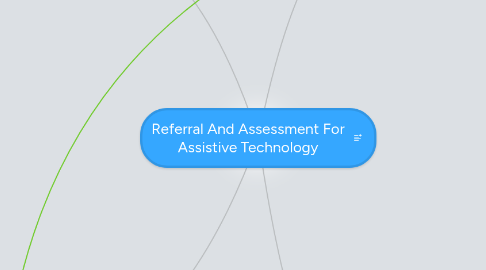
1. Step 1: Referral
1.1. Student Data or Personal Information
1.2. Medical Data for Vital Concerns
1.3. Vision and Hearing Reports
1.4. Any Technology or Equipment Currently in Use
1.5. Any Previously Used AT Services
1.6. This Step is very important.
1.6.1. First Step to Suggest Student Needs Help
1.6.2. Allows Student's Educational Relationship or Family Relationship to Suggest Help Is Needed
1.6.3. Time Sensitive
1.6.3.1. As Soon As Student is Found to Need Help
1.6.3.2. Student May Get Into Habit of Doing Wrong
1.6.3.3. Needs to Be Assessed Before Student Gets Out of Present Educational Stage
1.6.4. Allows Everyone Involved in Student's Education to Become Aware of Student's Needs
2. Step 3: Individualized Education Program Team
2.1. Team Concept in Mind
2.2. Multidisciplinary in Nature
2.3. Consider Student's Learning Goals
2.4. How AT Allows Student to Assess Curriculum
2.5. Training Needs for Student
2.6. Training Needs for Those Working with Student
2.7. Procure Device
2.7.1. Procure Device
2.7.2. Research Throughly
2.7.3. Try Trial Bases First
2.7.3.1. Borrow
2.7.3.1.1. From Company
2.7.3.1.2. Previous Child Who Has Outgrown or Out Used
2.7.3.2. Loaner Programs
2.7.3.3. Lease
2.7.4. Know How To Use
2.7.5. Collect Data on How Student Uses
3. Step 2: Conducting Assessment
3.1. Multifaceted Procedure
3.1.1. Direct Observation
3.1.1.1. Cognitive Skills
3.1.1.2. Current Use of AT Devices
3.1.1.3. Sensory Skills
3.1.1.4. Motor Skills
3.1.1.5. Communication Skills
3.1.1.6. Social Skills
3.1.2. Interviews
3.1.2.1. Family Concerns and Expectations
3.1.2.2. Perceived Needs and Abilities of Student
3.1.2.3. Academic Expectations
3.1.2.4. Diagnostic Information
3.1.2.5. Medical Information
3.1.3. Formal Assessment
3.1.3.1. Activities in Predetermined Environments
3.1.3.2. Development and Publication ofFormal Instruments
3.1.3.3. Match to Student
3.1.3.3.1. Age
3.1.3.3.2. Experiences
3.1.3.3.3. Cognitive Level
3.1.3.3.4. Behavioral Issues
3.1.3.3.5. Social Skills
3.1.4. Putting It All Together
3.1.4.1. Construct Comprehensives of Student's
3.1.4.1.1. Strengths
3.1.4.1.2. Needs
3.1.4.2. Formal Written Report
3.1.4.2.1. By Specialists
3.1.4.2.2. Presented to Student's IEP Team
4. Step 4: Implementation of Assistive Technology Device
4.1. Purchase Device
4.1.1. According to Student's Learning Outcome
4.1.2. Additional Training May Be Needed
4.2. Short-term Assistance For:
4.2.1. Monitoring
4.2.2. Classroom Teacher
4.2.3. Student
4.2.4. Family
4.3. Special Education Teacher
4.3.1. Significant Role
4.3.2. Making Sure Support Is Available
4.3.3. Student is Successful
4.4. Learning Goals is Met
4.5. Check Lists are Used
4.5.1. Assess AT Device
4.5.2. Student's Use of AT Device
4.5.3. Informal Assessments
4.5.4. Use Multiple Times
4.6. Immediate Action
4.6.1. Any Item Marked NO or Undecided
